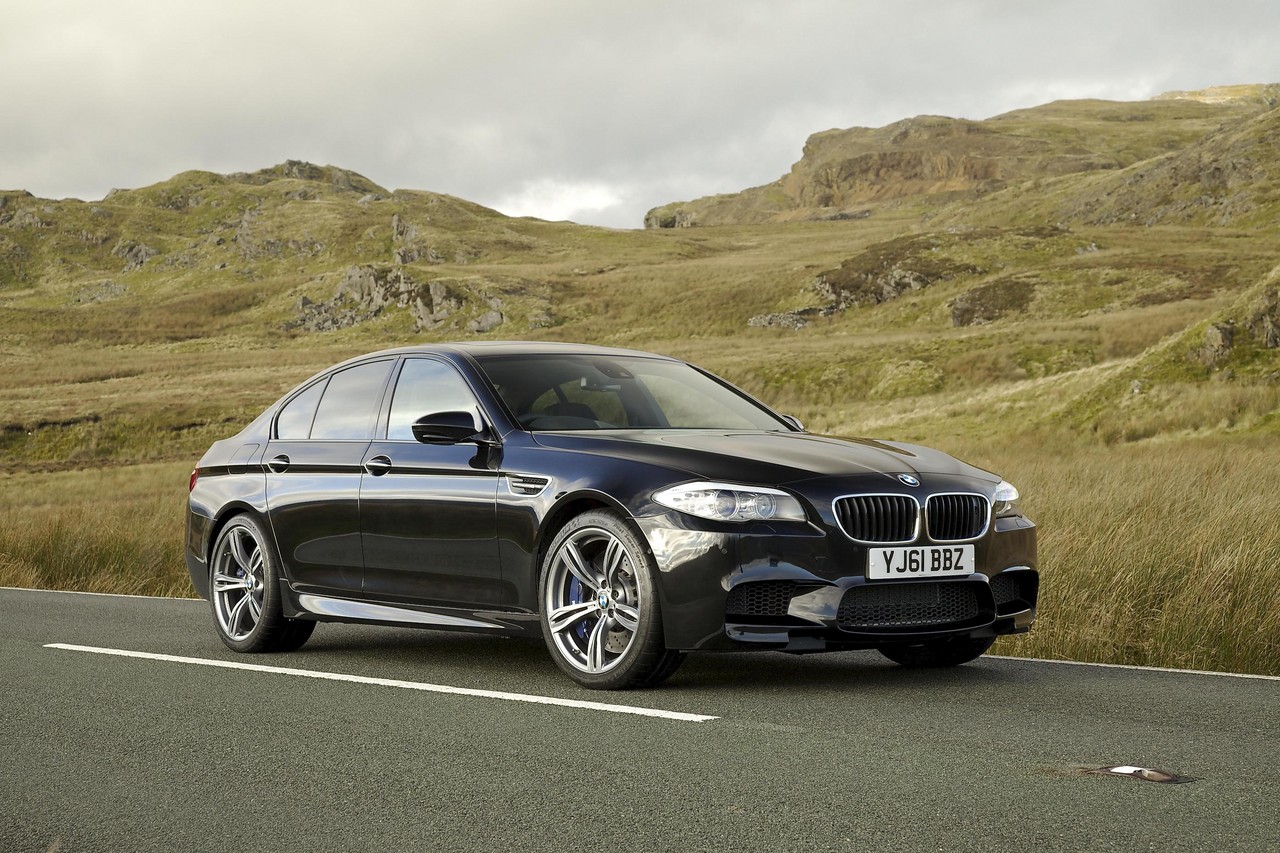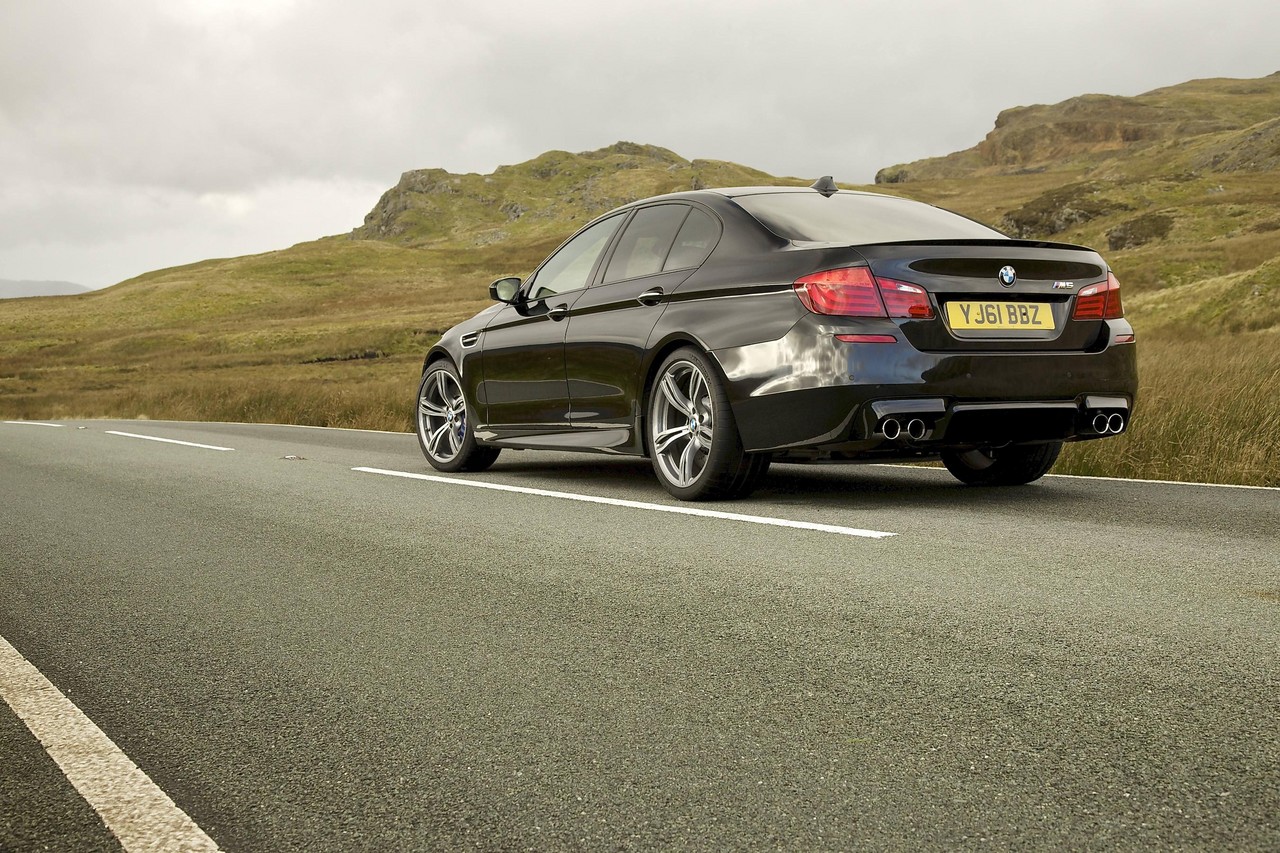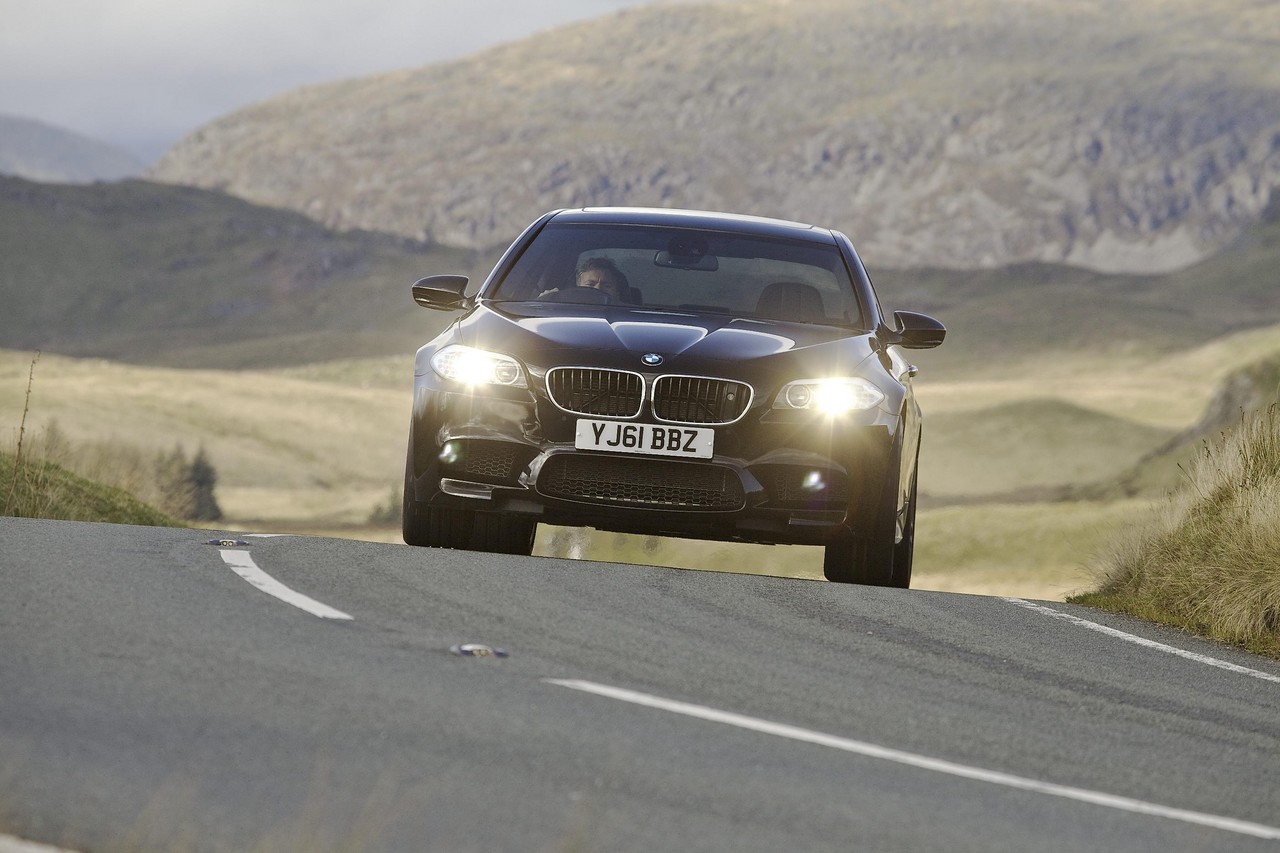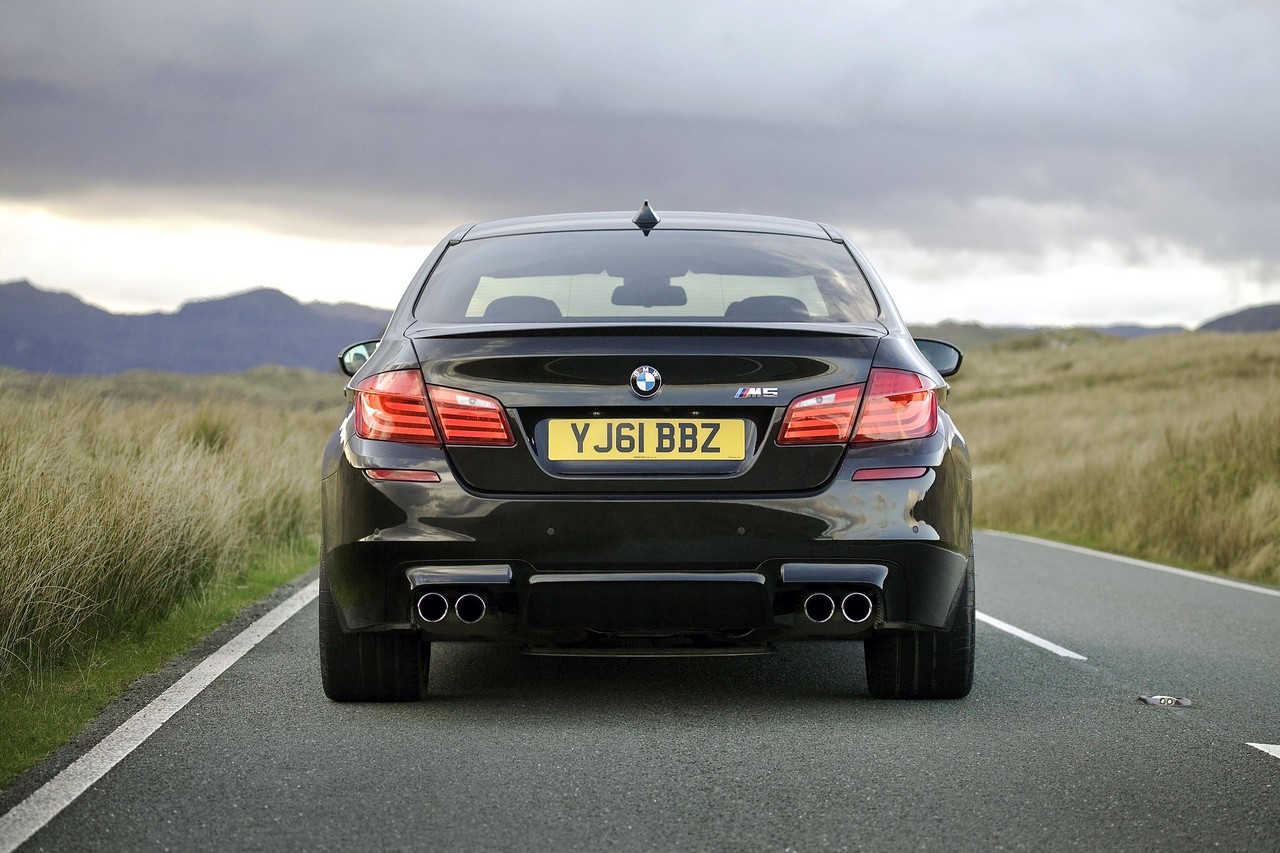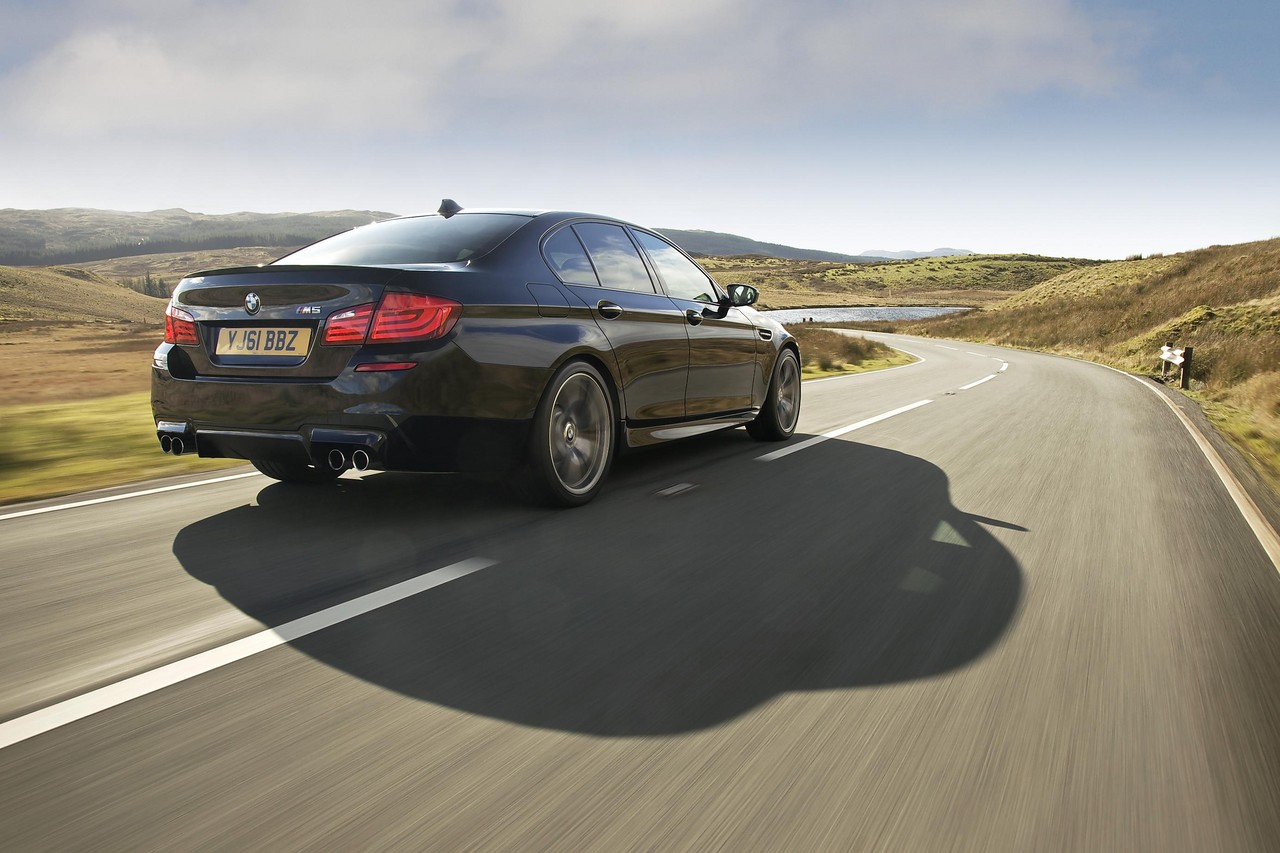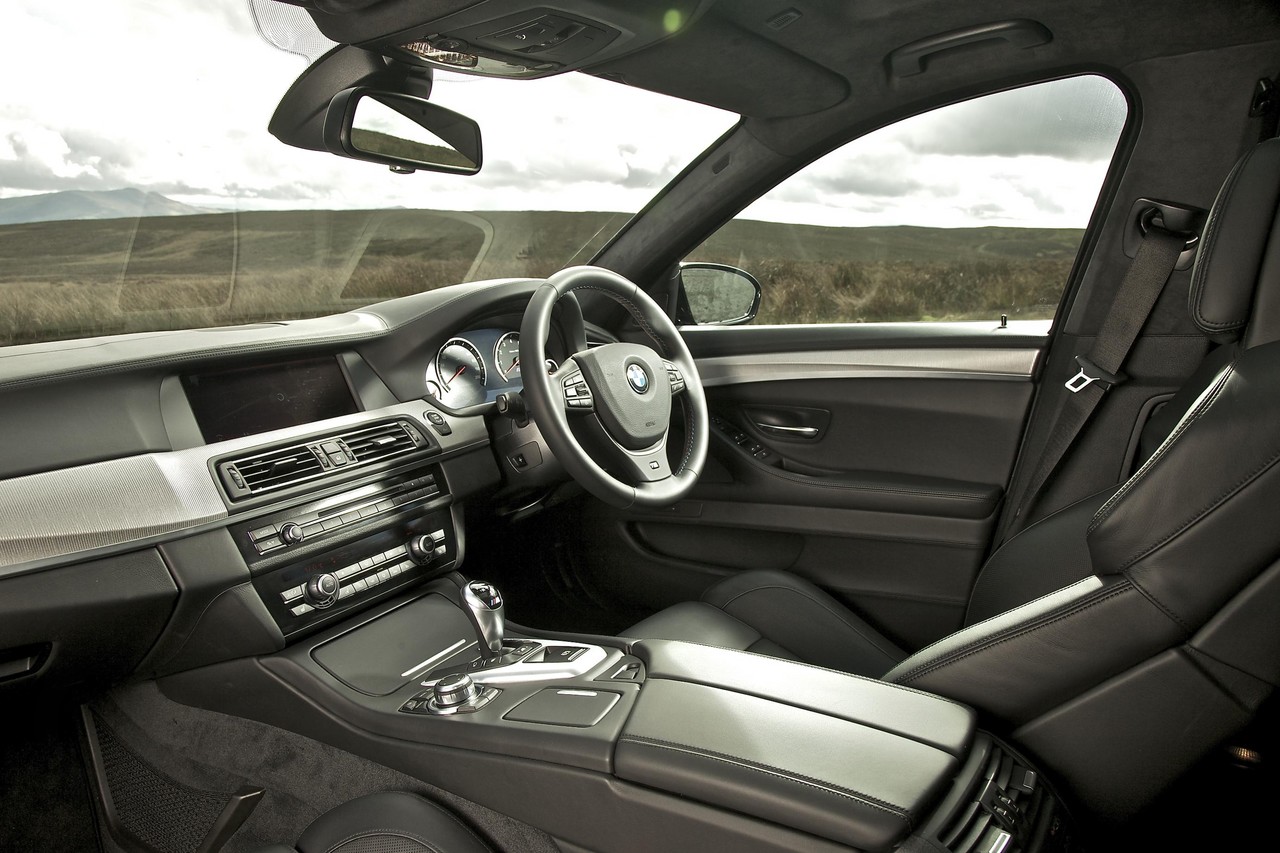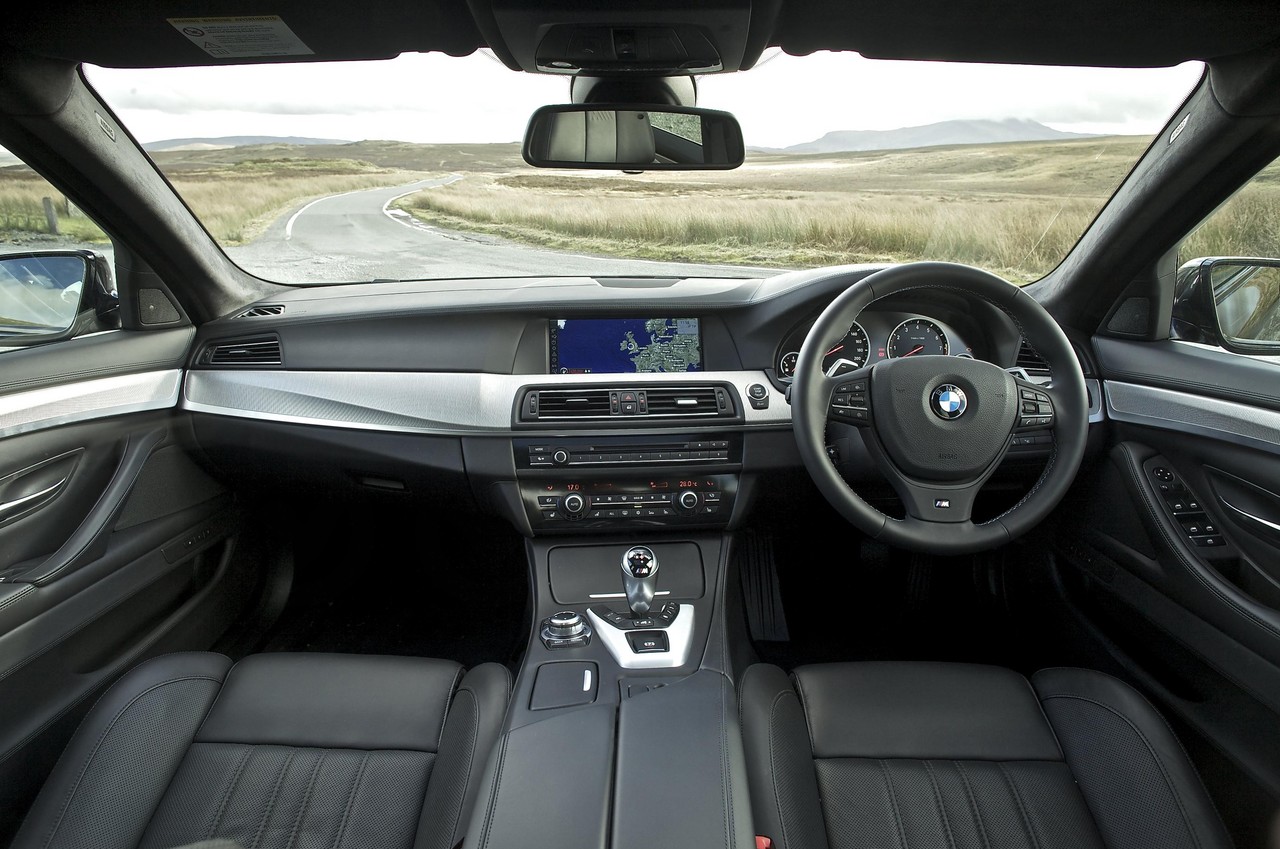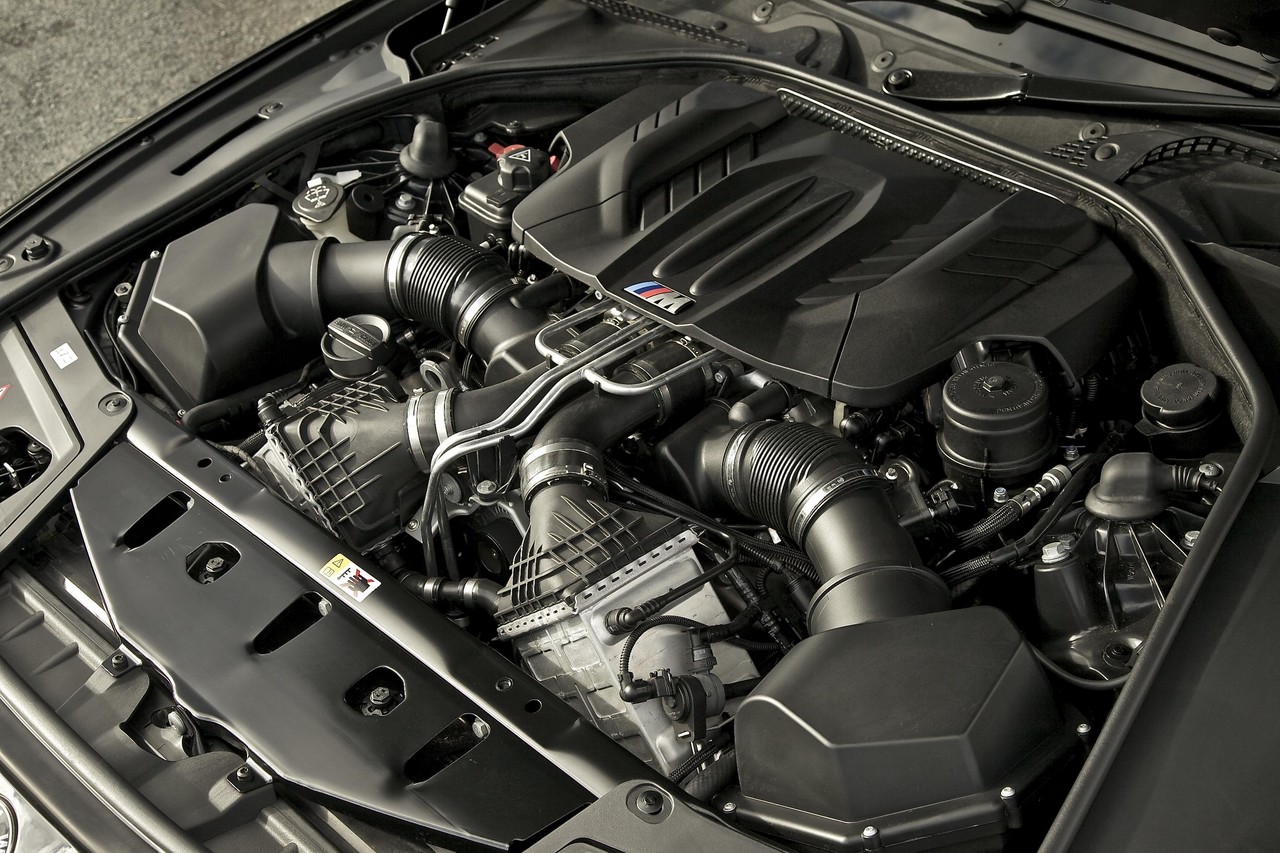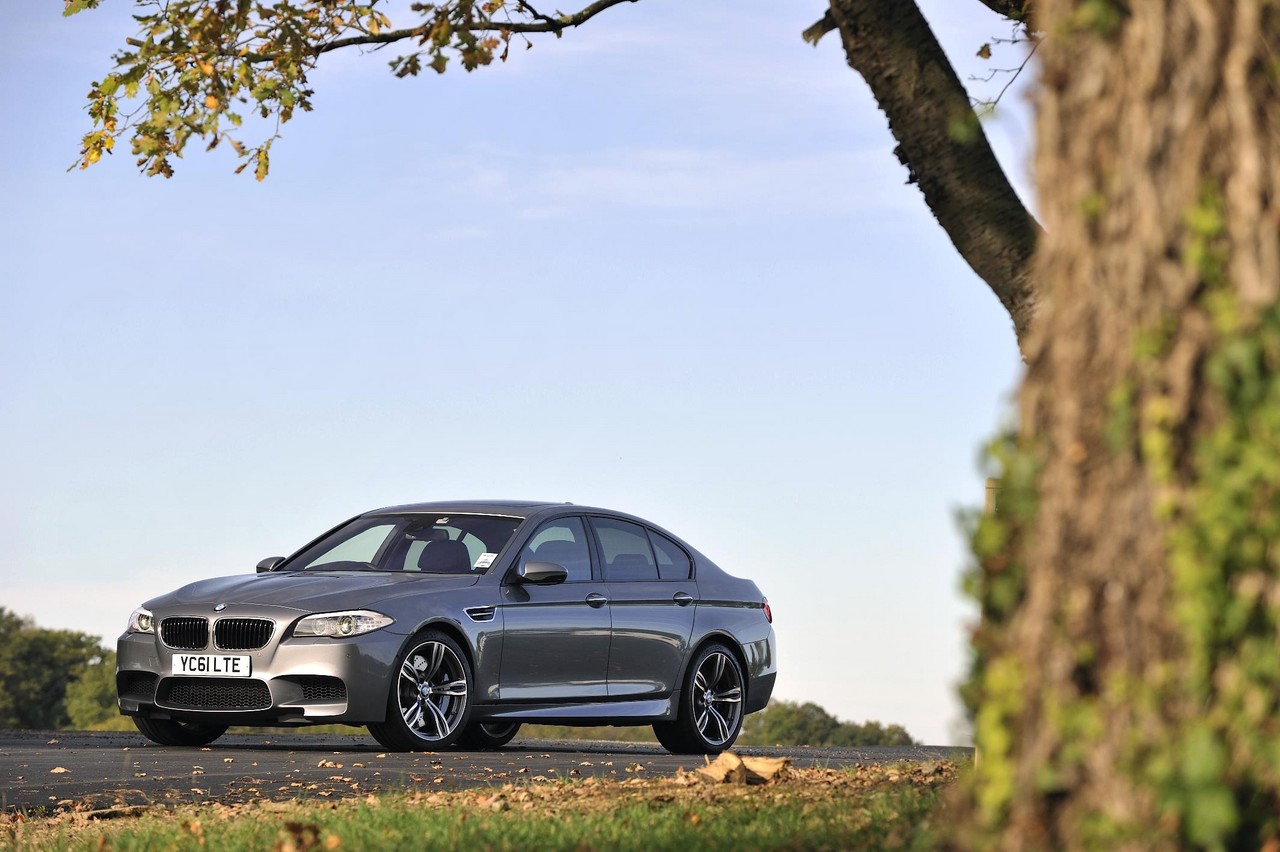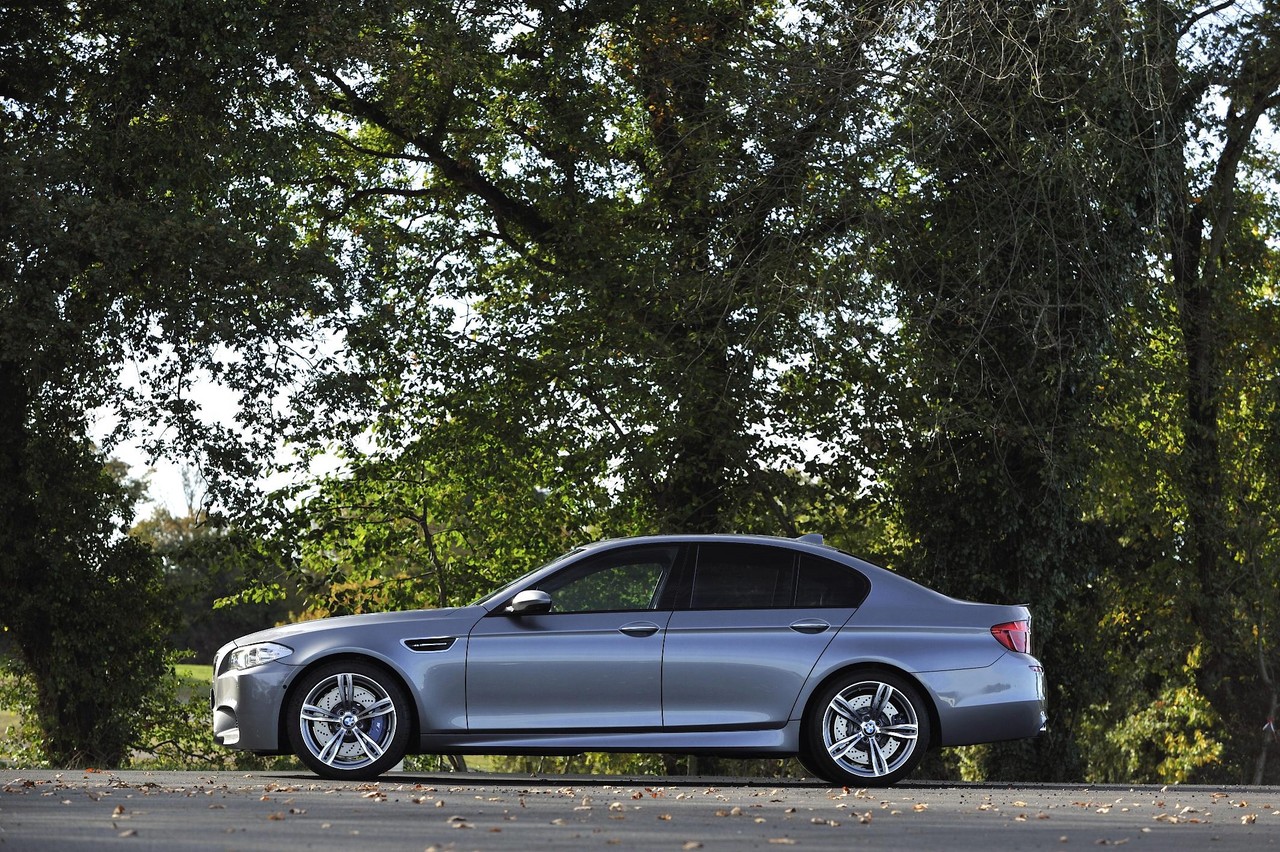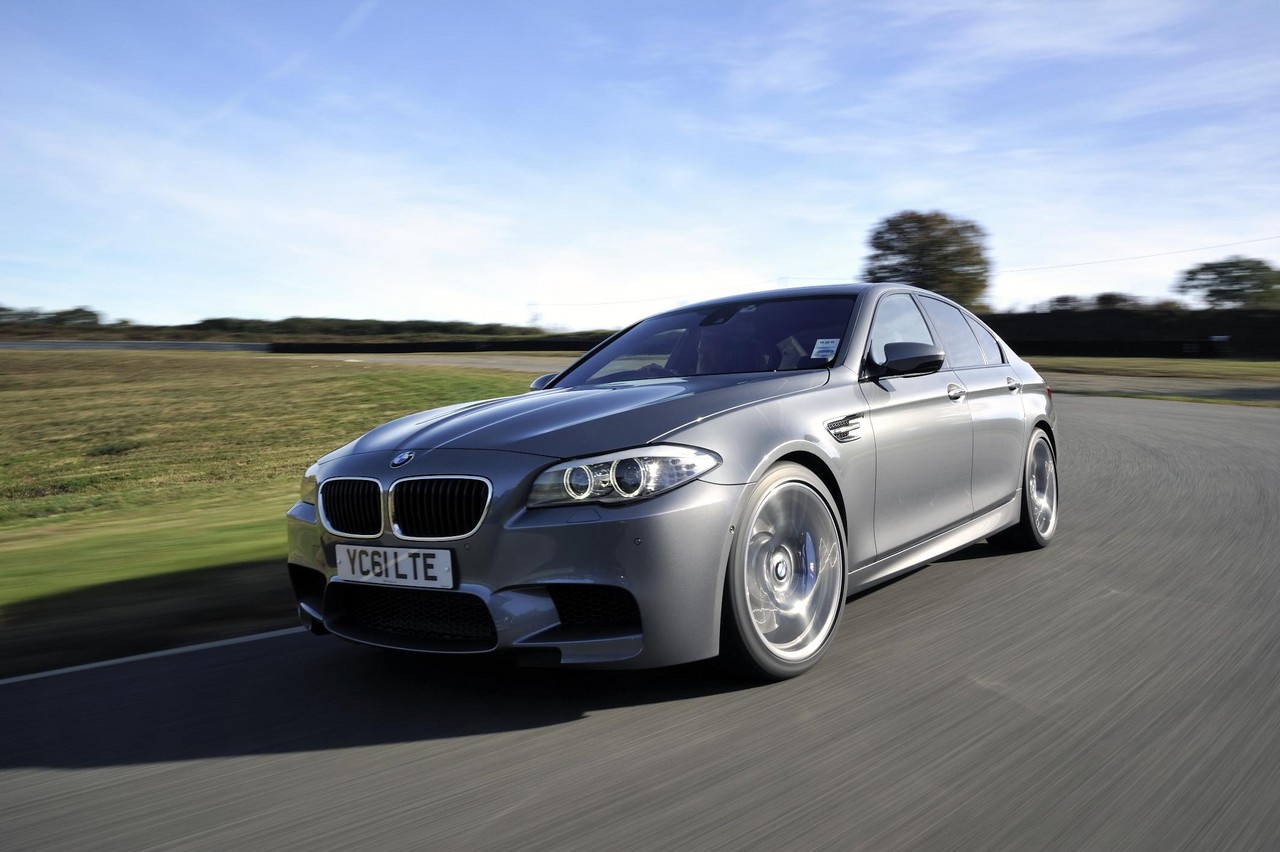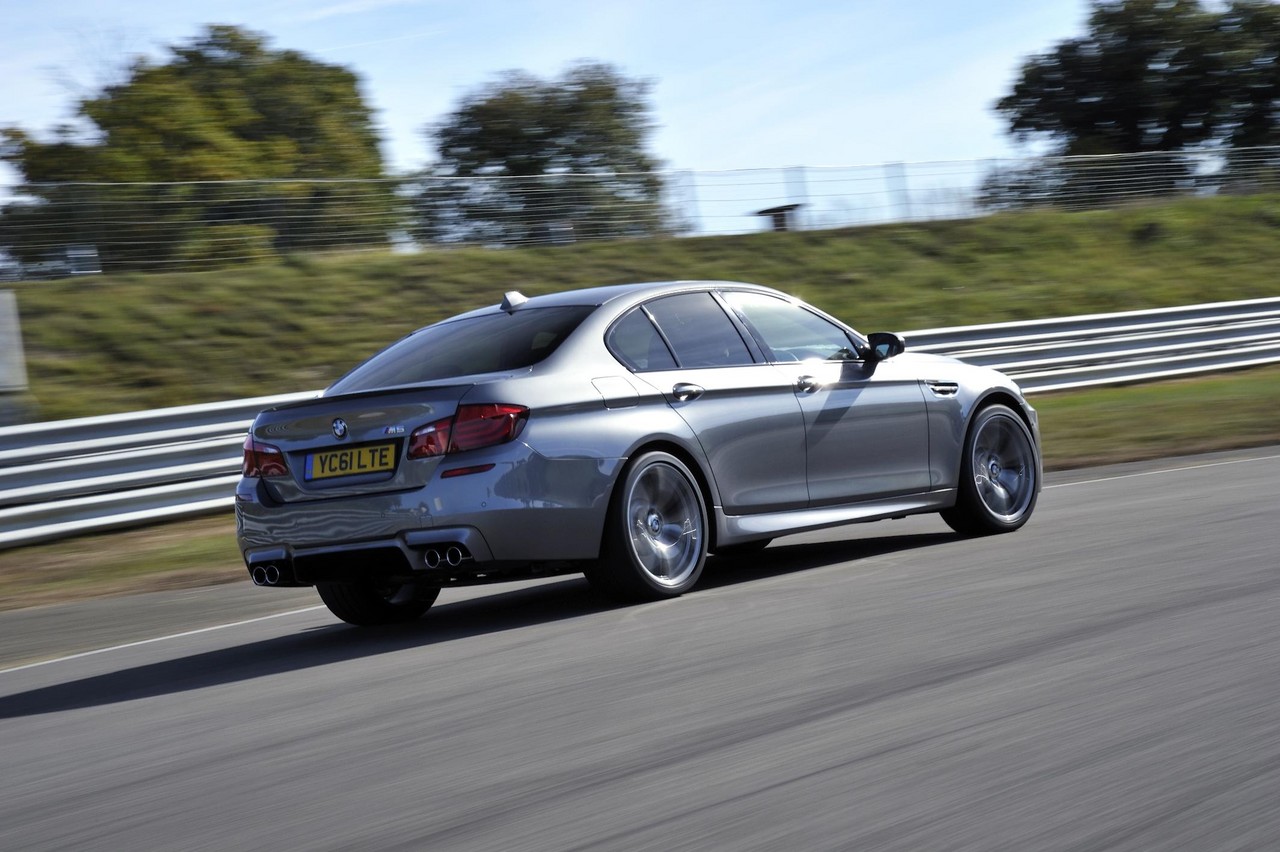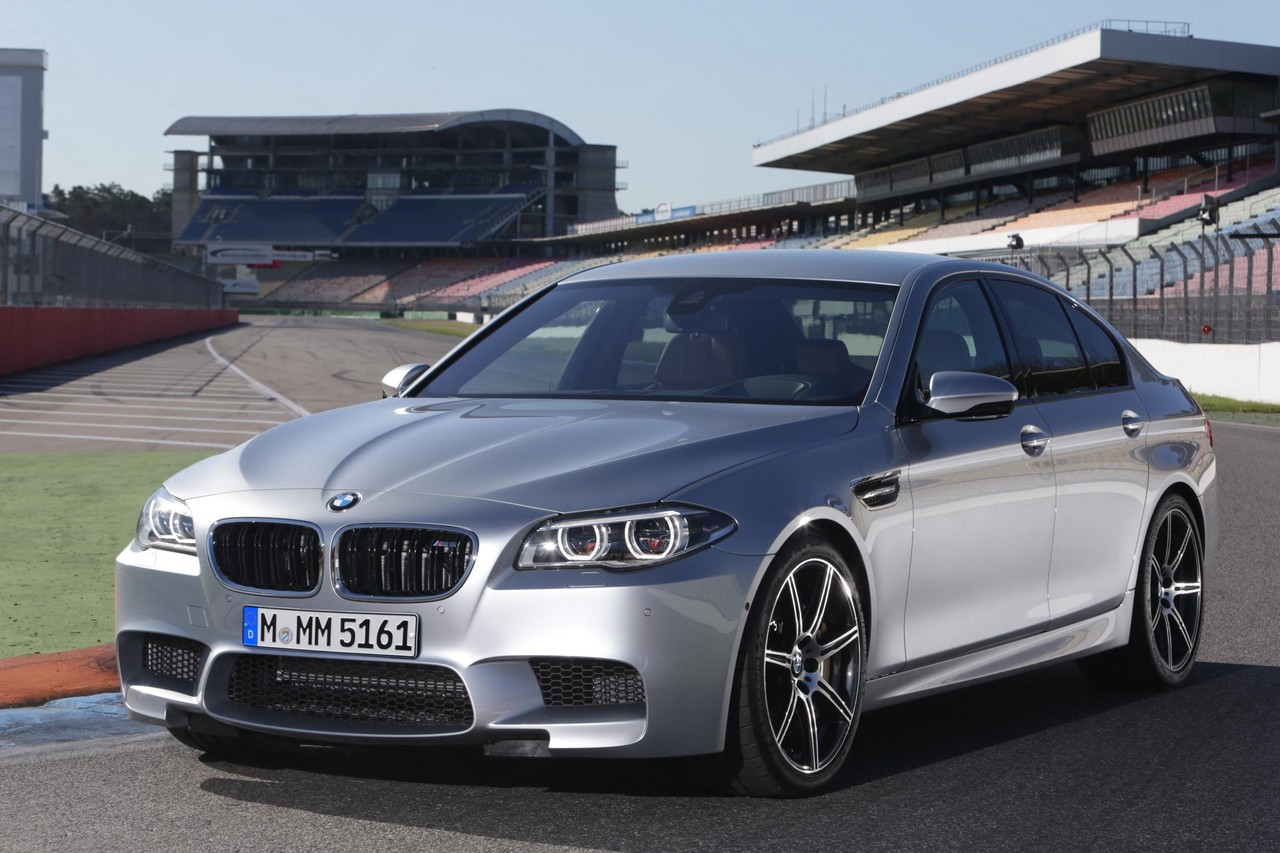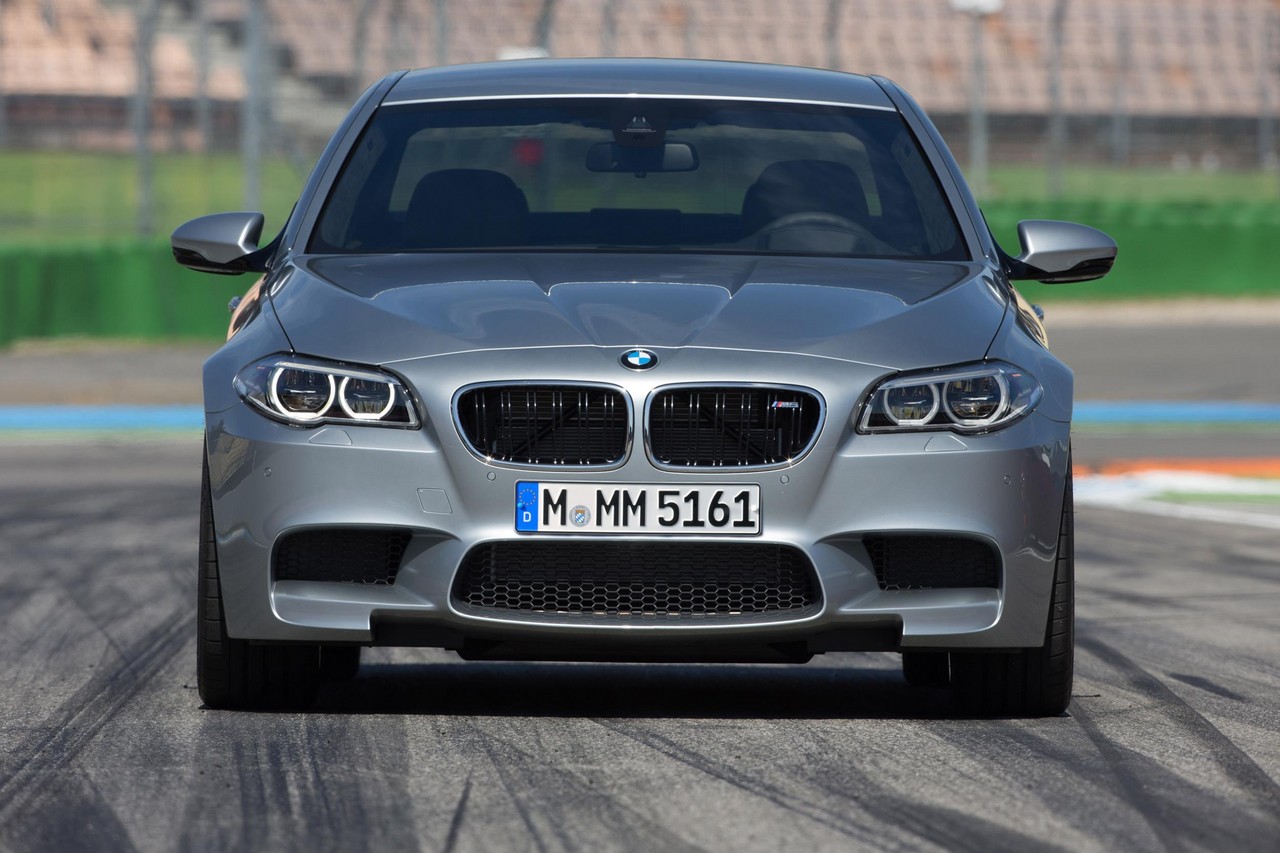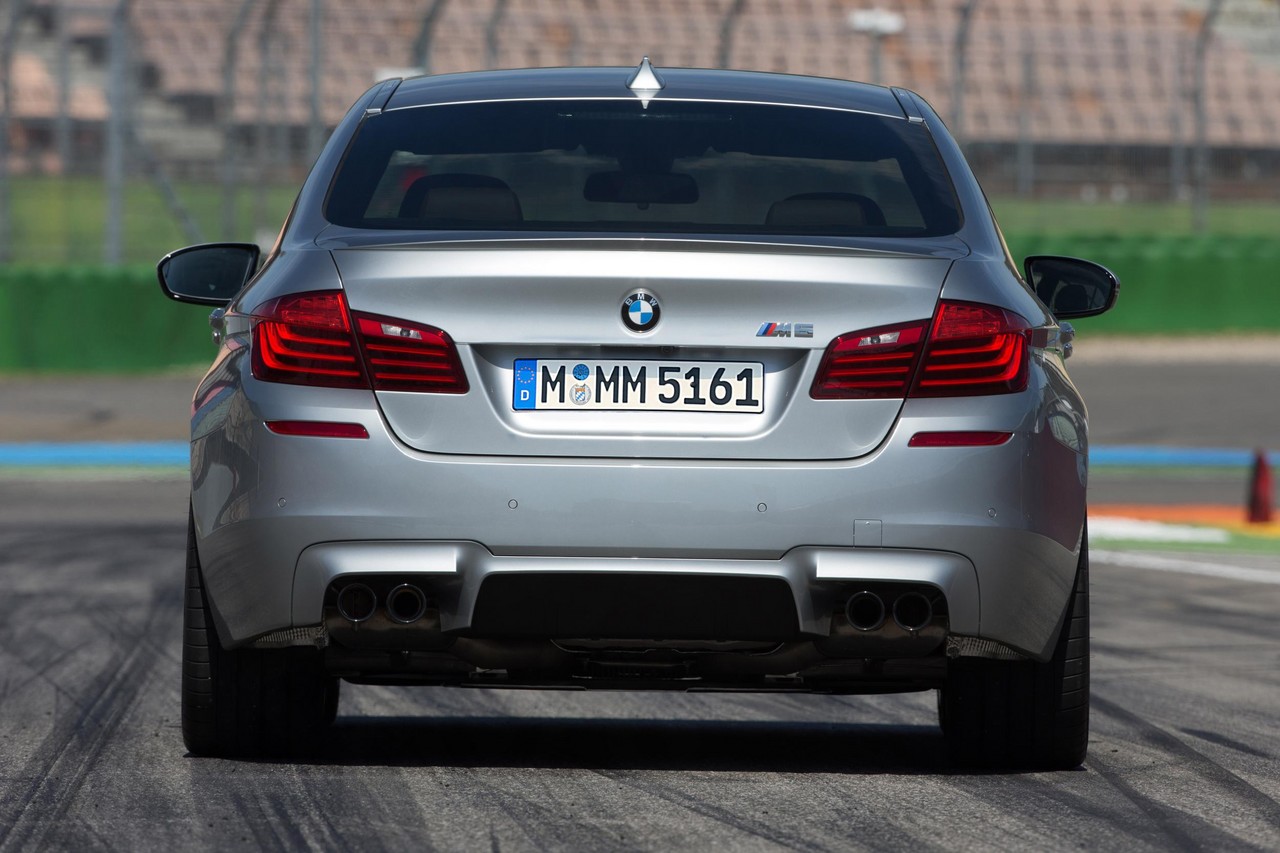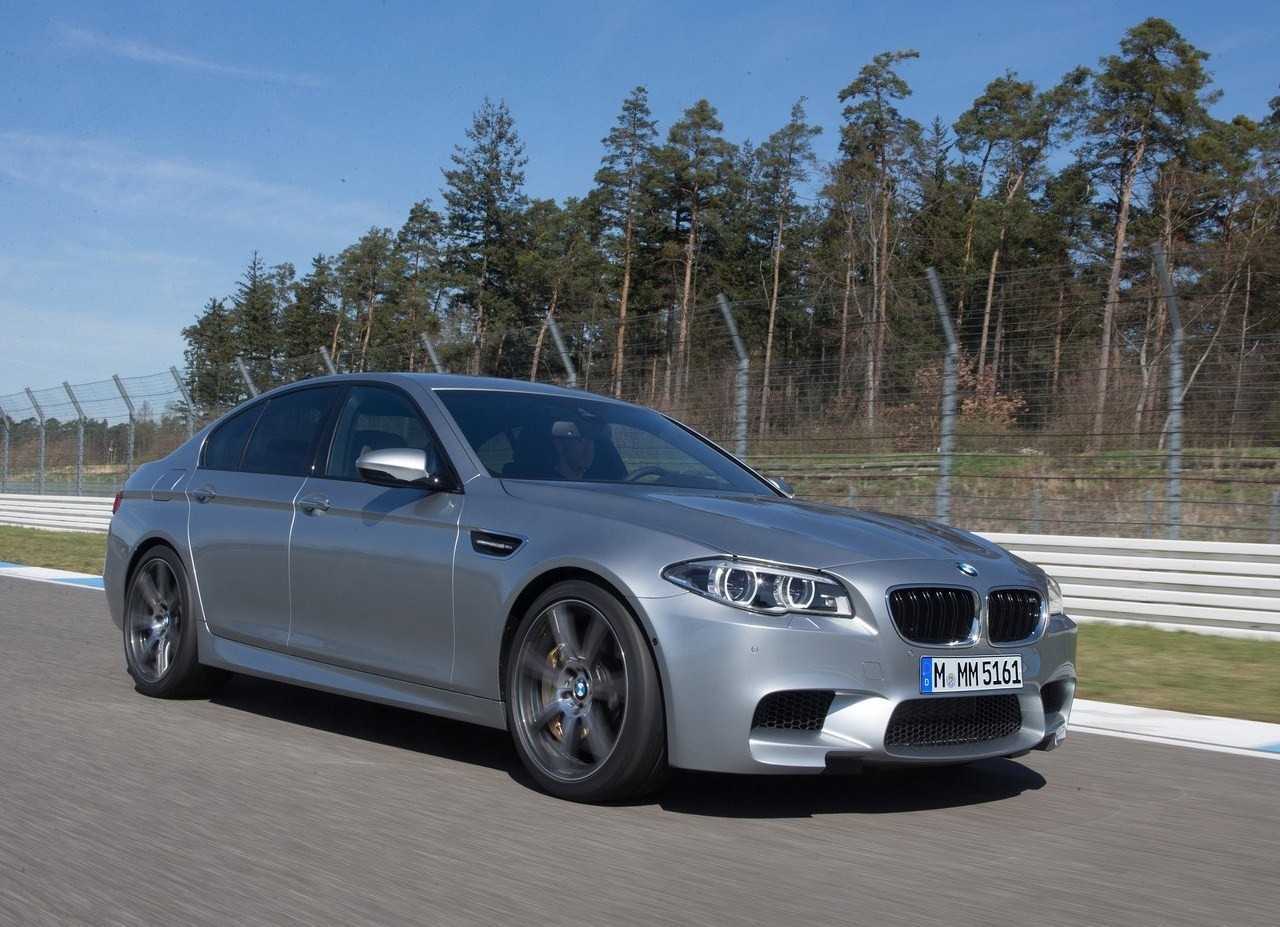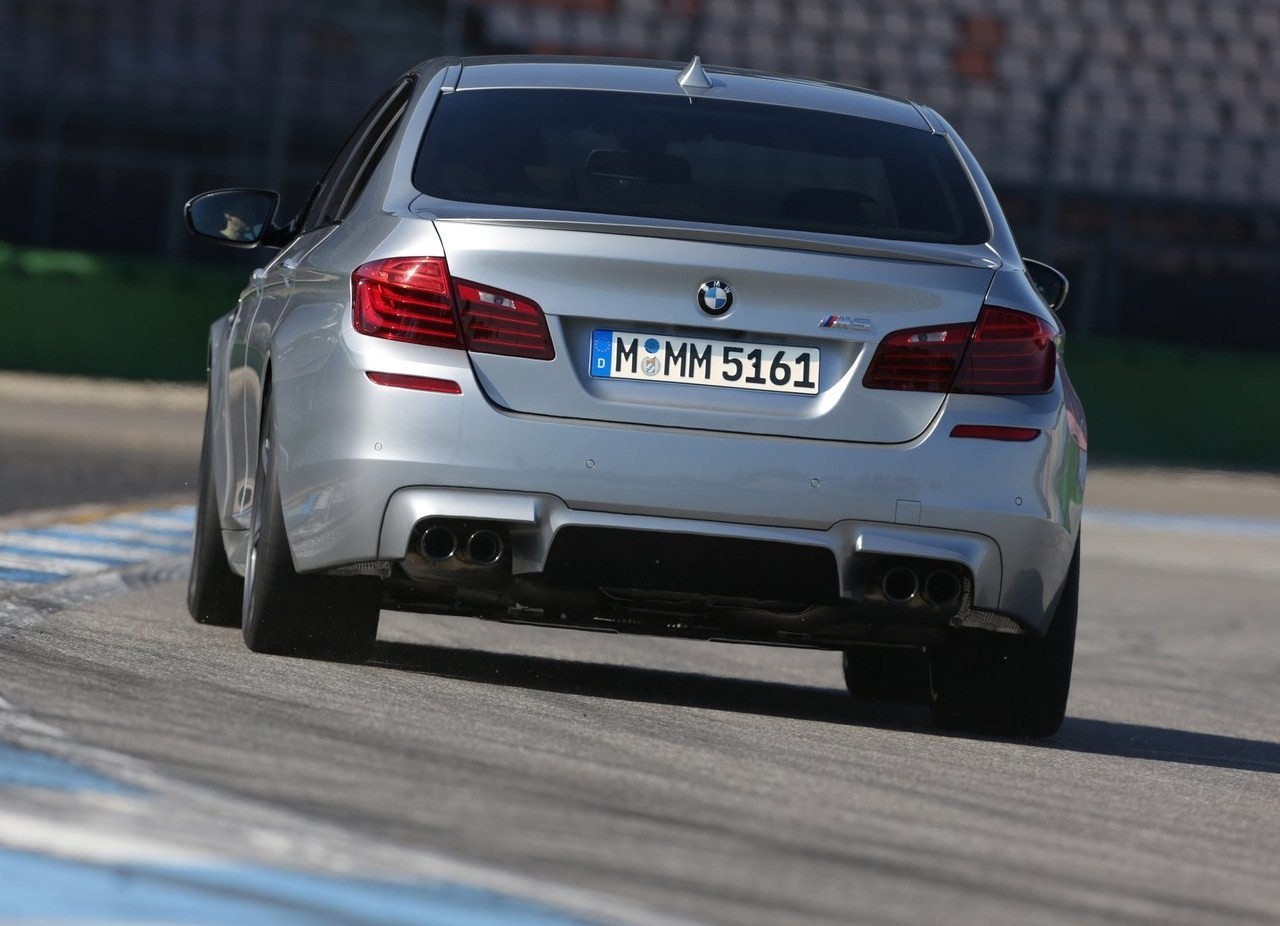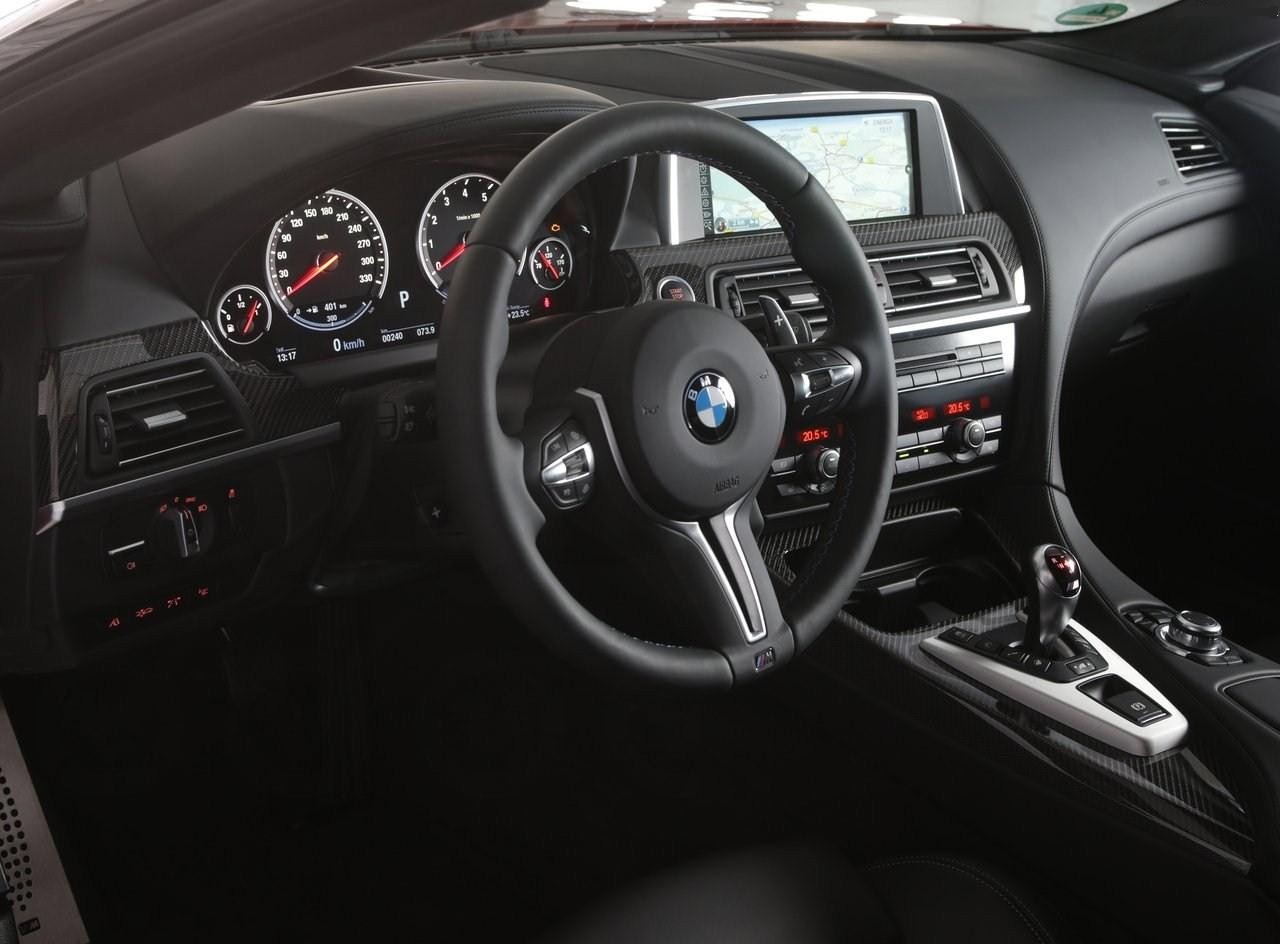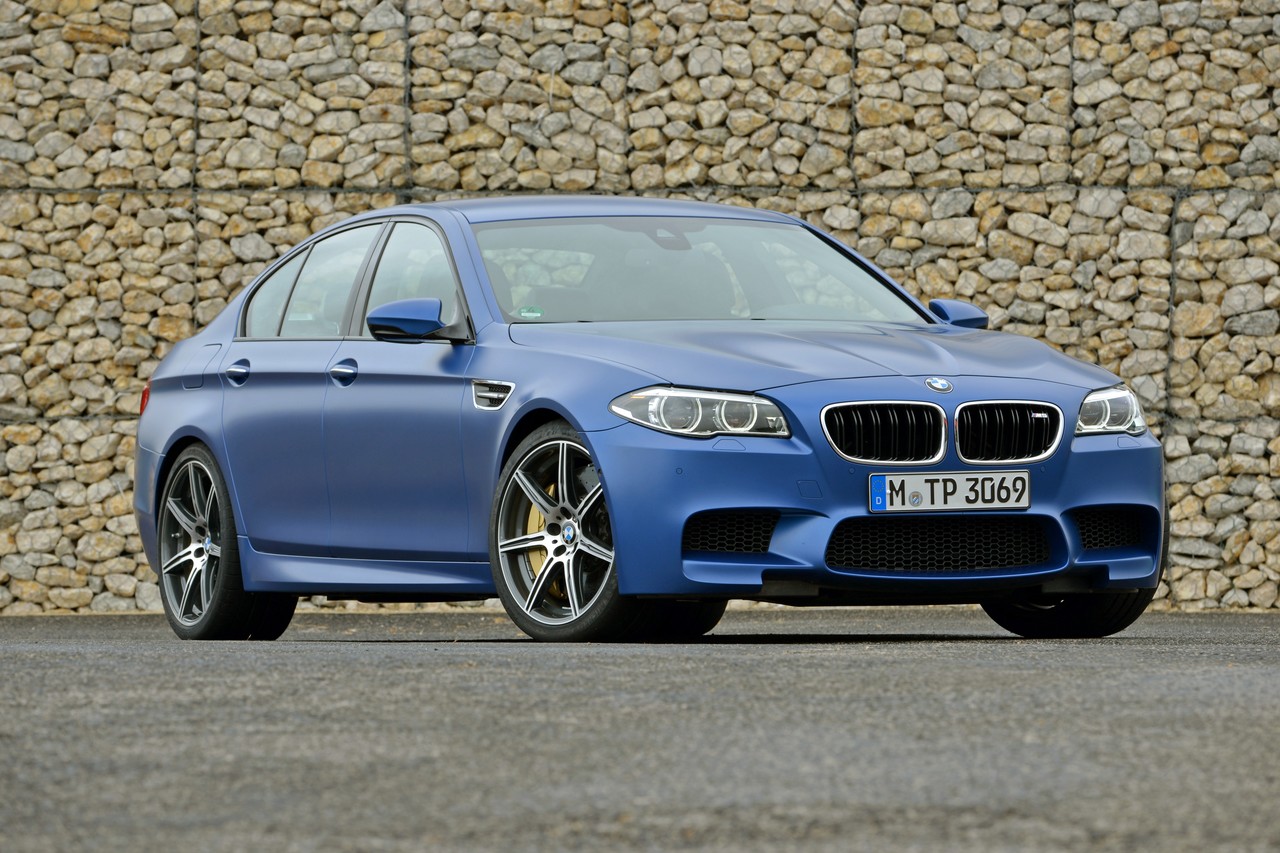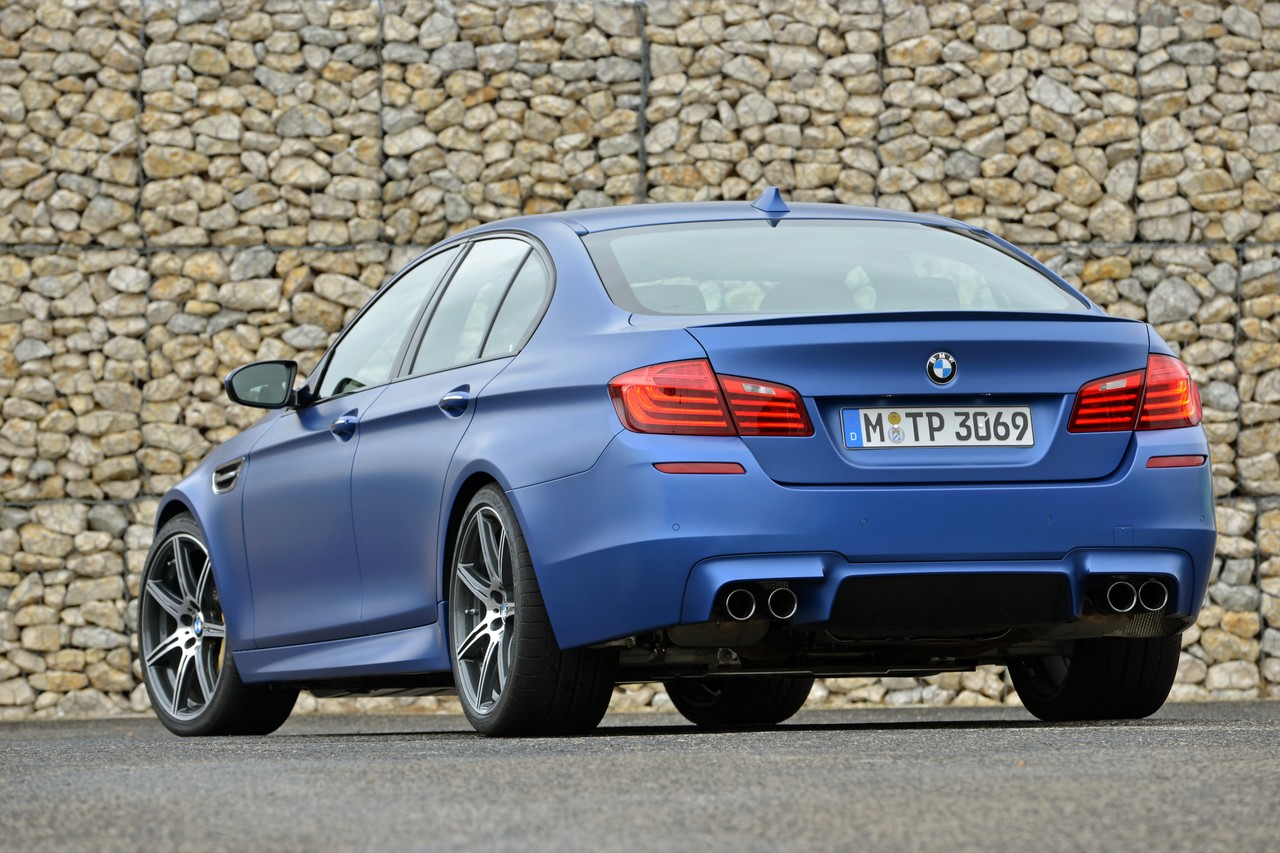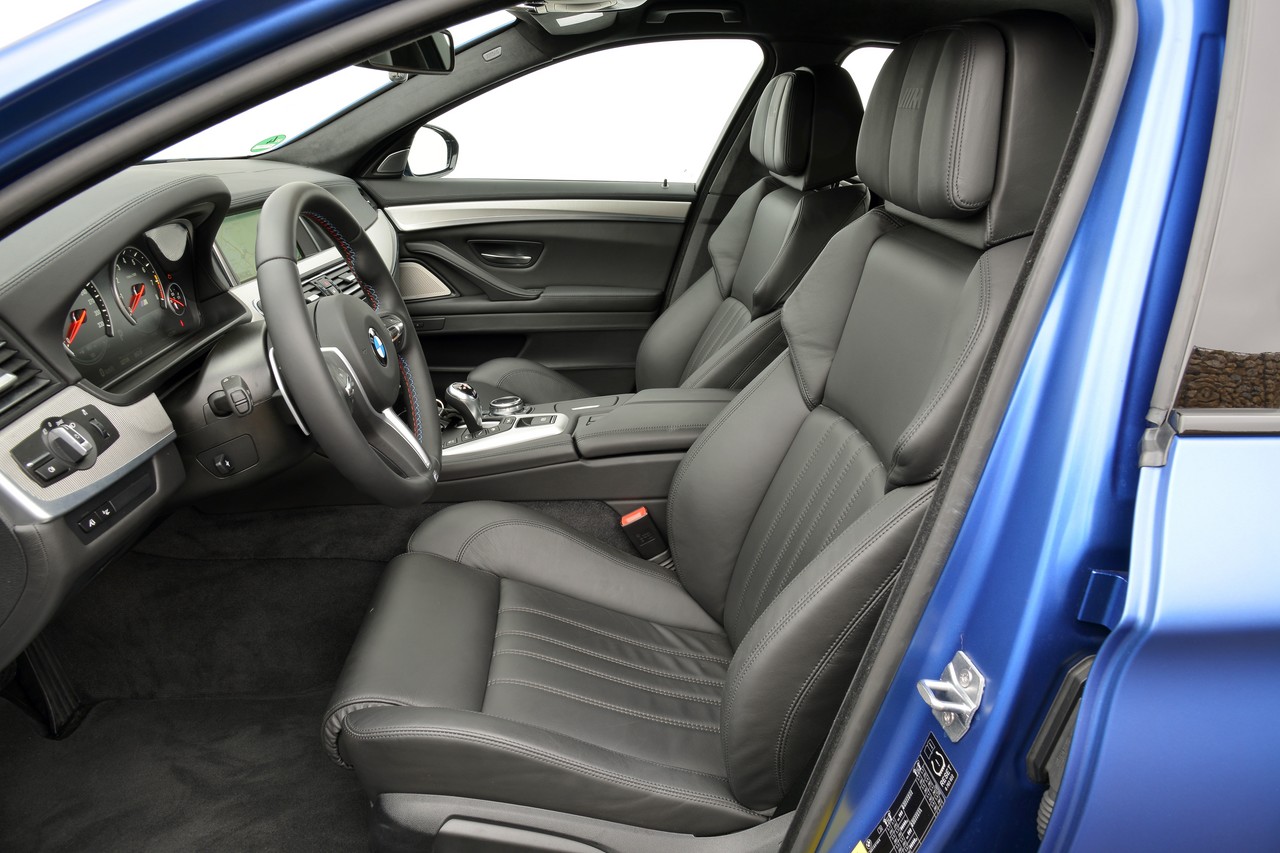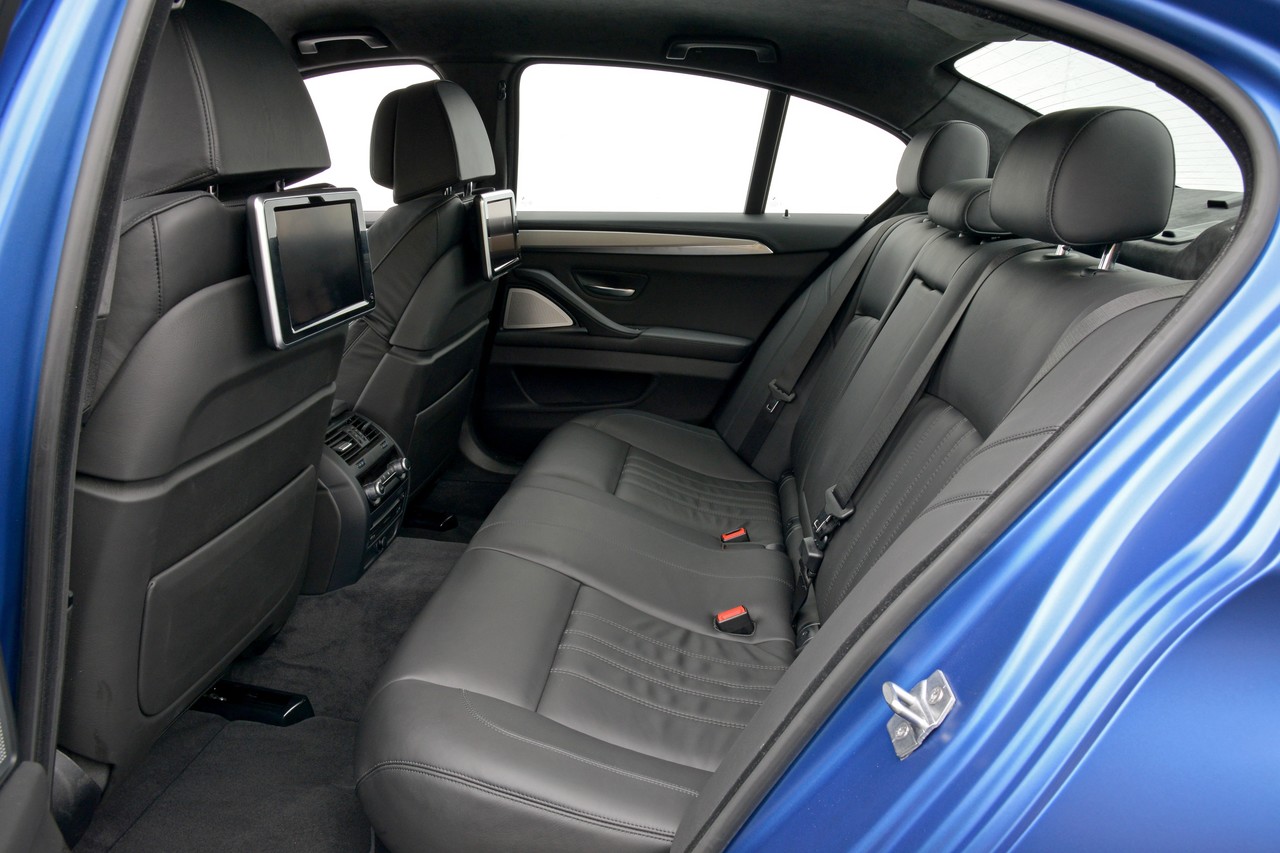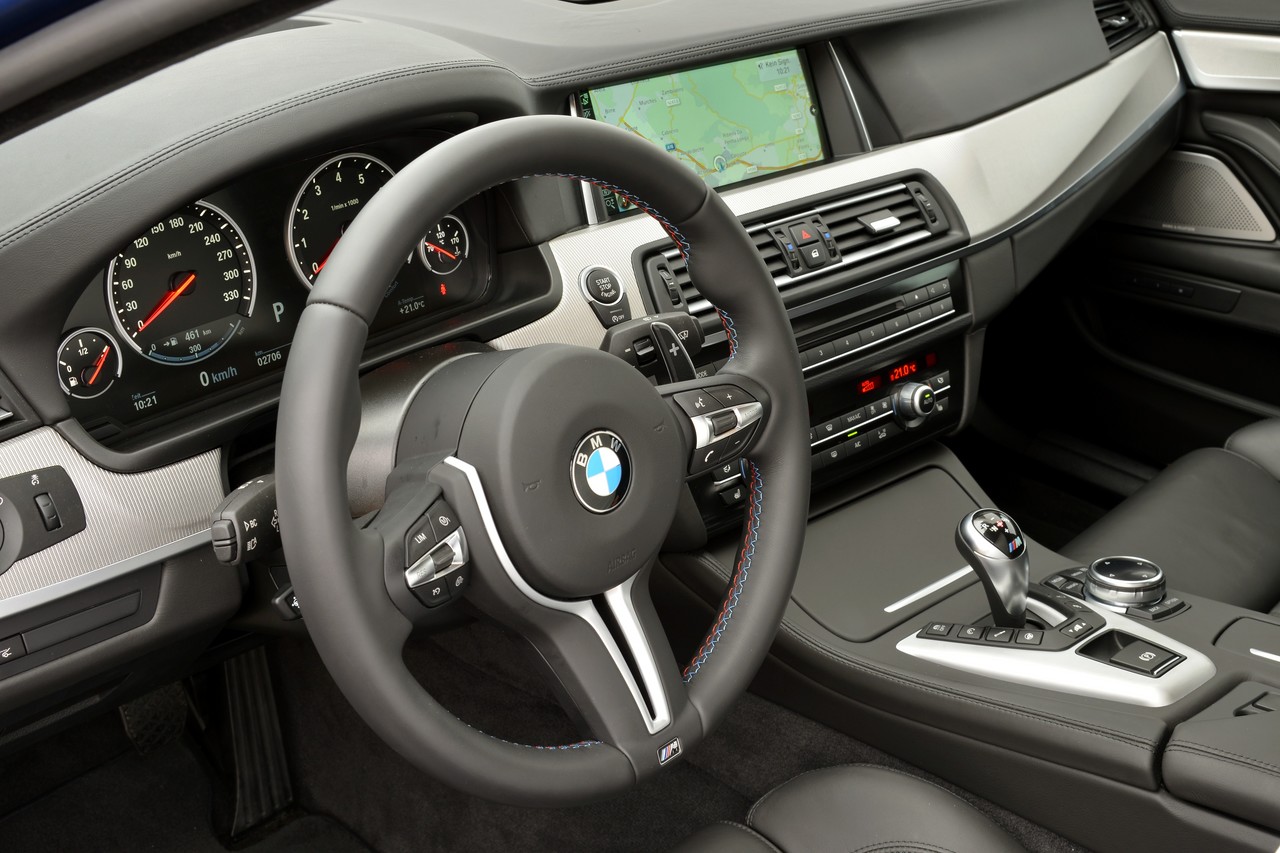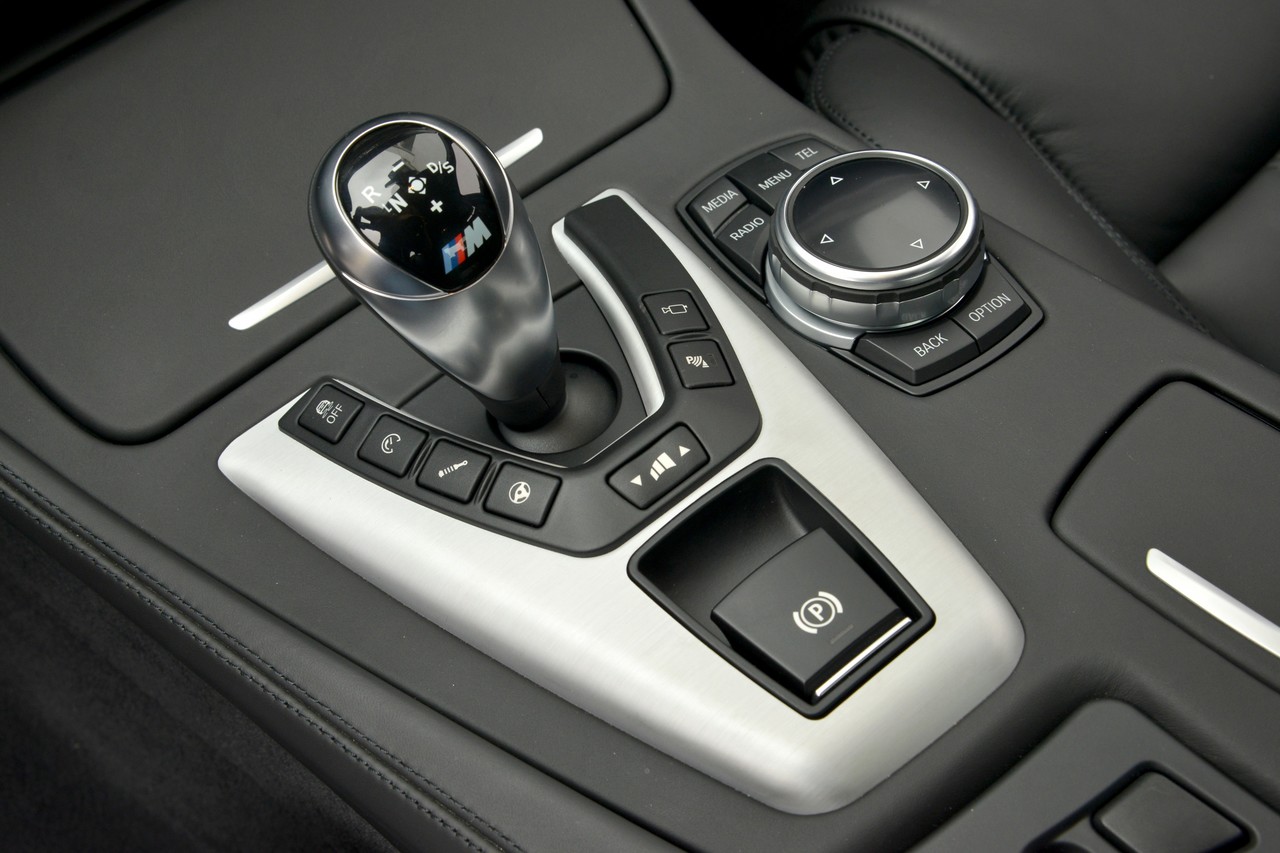
- Brutal acceleration from 4.4-litre twin-turbo V8 engine
- Impressive dynamics
- Responsive brakes
- Steering is accurate and direct…
- … but lacking in feel and feedback for pre-2013 F10 M5
- Weight dulls agility
- Lack of driver involvement
Review: BMW F10 M5 Sedan (2012-13)
Overview
Released in Australia in February 2012, the BMW F10 M5 was a high-performance sedan. Manufactured in Dingolfing, Germany, the rear-wheel drive F10 M5 sedan was powered by a 4.4-litre twin-turbo V8 petrol engine that was mated to a seven-speed double clutch transmission.
S63B44TU engine
With a closed-deck, aluminium-silicon alloy (Alusil) crankcase produced at BMW’s Landshut light-alloy foundry, the S63B44TU 90-degree V8 engine had an 88.3 mm bores and an 89.0 mm stroke for a capacity of 4395 cc. The S63B44TU featured an aluminium alloy cylinder head, high-precision direct petrol injection (at pressures up to 200 bar), twin-scroll turbochargers providing maximum boost pressure of 1.5 bar, a pulse-tuned exhaust manifold, double overhead camshafts, variable intake and exhaust camshaft timing (double VANOS), four valves per cylinder, BMW’s ‘Valvetronic III’ variable valve control, a compression ratio of 10.0:1, DME MEVD17.2.8 engine management and wet sump lubrication.
The F10 M5 could accelerate from rest to 100 km/h in 4.4 seconds and to 200 km/h in 13.0 seconds. Over the combined EU test cycle, fuel consumption was 9.9 litres per 100 km. Maximum speed was electronically-limited to 250 km/h. Furthermore, the driver could select from Efficient, Sport and Sport Plus drive modes.
The M5 was fitted with BMW’s EfficientDynamics technologies which included:
- An ‘Auto Start Stop’ function that enabled the engine to shut down when the vehicle was stationary in traffic; and,
- ‘Brake Energy Regeneration’ which controlled alternator output to charge the battery when the vehicle was braking or coasting.
M Double Clutch Transmission (DCT)
The double clutch transmission (DCT) combined two gearbox components in a common housing and featured two oil-cooled wet clutches. One of the clutches operated the even gears (i.e. 2, 4 and 6), while the other clutch operated the uneven gears (i.e. 1, 3, 5, 7 and reverse). When driving, one of the clutches was always closed and the other open. When up- or down-shifting, the transmission control unit would pre-select the next gear and the clutches would be activated in an alternating process such that one clutch would open just as the other was closing.
The DCT had automated (D) and manual (S) gearshift modes, while the driver could select gears by the gear lever or steering wheel gearshift paddles. Via a rocker switch positioned behind the gear lever, the driver could select three settings:
- D1: smooth gearshifts and maximum fuel efficiency;
- D2: faster gearshifts (accompanied by jolts at higher engine speeds) with gear changes according to engine speed and load; and,
- D3: rapid gearshifts for with gear changes delayed for higher engine speeds.
The DCT also had a Launch Control function and ‘Low Speed Assistance’ function that kept the vehicle moving at low speeds in stop-start traffic.
Gear ratios for the DCT were 4.806 (1st), 2.593 (2nd), 1.701 (3rd), 1.277 (4th), 1.000 (5th), 0.844 (6th) and 0.671 (7th); the final drive ratio was 3.154:1.
Dimensions and body
Compared to its E60 M5 predecessor, the F10 M5 was 55 mm longer (at 4910 mm), 45 mm wider (1891 mm), 13 mm lower (1456 mm) and had a 75 mm longer wheelbase (2964 mm); its drag coefficient was 0.33 Cd. Although the bonnet, front quarter panels and doors were made from aluminium, unladen weight increased by 190 kg to 1945 kg.
Compared to the F10 5-Series sedan , the M5 could be identified by its unique front apron design, bonnet contour lines, M black slats within the kidney grille, flared wheel arches and LED headlight rings.
Suspension
The F10 M5 had double wishbone front suspension and an integral-V multi-arm rear axle. As standard, the suspension included BMW’s ‘Dynamic Damper Control’ which used electronically-controlled valves within the dampers to react to vertical movement of the wheels. As a result, the electronically-controlled dampers continually adjusted to road conditions; the driver could select from Comfort, Sport and Sport Plus settings.
Steering
The F10 M5 had variable ratio, hydraulic rack-and-pinion steering with power assistance (BMW’s ‘Servotronic’) varied according to speed. Furthermore, the driver could select from Comfort, Sport and Sport Plus settings which also varied power assistance.
| Engine | Trans. | Peak power | Peak torque | |
|---|---|---|---|---|
| M5 | 4395 cc S63 B44TU twin-turbo petrol V8 | 7sp DCT | 412 kW at 6000-7000 rpm | 680 Nm at 1500-5750 rpm |
Safety equipment
Standard safety equipment for the BMW F10 M5 included dual front airbags, front side airbags, full-length curtain airbags (i.e. for front and rear occupants), ABS, electronic brake force distribution, brake assist, electronic stability control (BMW’s ‘Dynamic stability Control’), cornering brake control, traction control, active front seat head restraints and front seatbelts with pretensioners and load limiters. Furthermore, the bonnet could rise in the event of a pedestrian collision to reduce the severity of the pedestrian’s subsequent impact with the bonnet.
The F10 M5 was also fitted with BMW’s Active Protection system which – in emergency situations – would tension the front seatbelts, position the front passenger seat for optimal airbag deployment (only for ‘comfort’ seats) and ensure seatbelt position would not interfere with deployment of the front side airbags.
As an extra-cost option, the F10 M5 was available with:
- Lane Change Warning;
- Lane Departure Warning; and,
- BMW Night Vision with pedestrian recognition.
Brakes
The BMW F10 M5 had 400 mm by 36 mm vented front brake discs with six-piston calipers (radially bolted to the pivot bearing) and 396 mm by 24 mm vented rear discs with single-piston calipers. Furthermore, the braking system included the following functions:
- Brake Drying: to keep the brake pads dry, the brake pad was pressed against the rotor when the rain sensor detected moisture;
- Start-Off Assistant: applied the brakes for one second after the driver’s foot was removed from the brake pedal for uphill acceleration from rest; and,
- Brake Fade Compensation: applied additional braking force when the brakes were hot to compensate for the loss of braking ability that occurred in such situations.
Features: BMW F10 M5
Standard features for the BMW F10 M5 included forged 20-inch M Double Spoke alloy wheels (20 x 9.0J front and 20 x 10.0J rear) with 265/35 R20 99Y front and 295/30 R20 99Y rear tyres, BMW’s iDrive with ‘Professional’ navigation system, a 10.2-inch display, internet functionality, a six-disc DVD changer and digital TV reception, BMW’s Hi-Fi Professional sound system with 16 speakers, a 600 watt digital amplifier, Dolby Pro Logic sound processor, surround mode, 20GB hard drive and auxiliary inputs (3.5 mm/USB/iPod), Bluetooth mobile phone connectivity and audio streaming, power adjustable and ventilated ‘M’ front sports seats, full Merino leather upholstery, four-zone climate control air conditioning, cruise control with braking function, directional bi-xenon headlights with LED rings, front and rear fog lights, rear view camera, Surround View camera system (including Side View and Top View), front and rear parking sensors (BMW’s ‘Park Distance Control’), M leather steering wheel with gearshift paddles, 60:40 split and folding rear seats with through-loading, remote central locking with proximity key (BMW’s ‘Comfort Access’), power windows, power adjustable and heated door mirrors, a power adjustable steering column, head-up display, push-button start, driver memory settings (for the seat and steering column), a power-operated glass sunroof, ‘Aluminium Trace’ interior trim strips, Alcantara Anthracite roof liner, three 12 volt power sockets, ambient lighting, velour floor mats, an alarm and immobiliser
For the M5, the head-up display projected the vehicle’s speed, current gear, a multi-colour rev counter and gearshift lights.
Active M Differential
Fitted as standard, the Active M Differential was an electronically controlled multi-plate limited-slip differential with variable locking that could apportion power between the right and left rear wheel for maximum traction. The Active M Differential’s control unit was connected via FlexRay high-speed data transfer to the Dynamic Stability Control (DSC) system to calculate the locking force needed – from 0 to 100 per cent – based on throttle position, wheel speed and yaw.
Active Sound Design
Based on throttle inputs, Active Sound Design could use the M5’s audio system to provide an accurate reproduction of the engine’s sound into the cabin. When Sport or Sport+ drive modes were engaged, Active Sound Design would increase the volume of engine noise into the cabin.
Related links
- Press Kit: BMW F10 M5 (September 2011)
- Press Kit: BMW F10 M5 – Australia (February 2012)
- Specifications: BMW F10 M5 (February 2013)
Review: BMW F10 LCI M5 Sedan (2013-16)
Overview
Available from September 2013, the BMW F10 LCI M5 could be identified by its ‘M’ kidney grille with twin slats and tail-lights with thin LED strips. The F10 LCI M5 was also fitted with BMW’s ‘Competition Package’ as standard which included an 11 kW increased in peak power (to 423 kW at 6000 rpm), suspension and damping modifications, a 10 mm lower chassis and stiffer stabiliser bars.
| Engine | Trans. | Peak power | Peak torque | |
|---|---|---|---|---|
| M5 | 4395 cc S63 B44TU twin-turbo petrol V8 | 7sp DCT | 423 kW at 6000 rpm | 680 Nm at 1500-5750 rpm |
Safety equipment
Compared to its F10 predecessor, standard safety equipment for F10 LCI M5 was extended to include lane departure warning, forward collision warning and pedestrian warning with autonomous braking.
Features
Standard features for the BMW F10 LCI M5 were extended to include a sixteen speaker HiFi sound system with a 600 watt digital amplifier and Dolby Pro Logic signal processing and automatic soft-close doors.
BMW M5: 30 Jahre M5 edition
Production of the 30 Jahre M5 commenced in July 2014 to commemorate the thirtieth anniversary of the original BMW M5. Worldwide production of the M5 30 Jahre was limited to three hundred vehicles, with only fifteen allocated to Australia.
Compared to the Australian-delivered M5 (which included the Competition Package that was optional in overseas markets), the 30 Jahre M5 was distinguished by its higher output engine which produced 441 kW at 700 Nm and could be identified by its Frozen Dark Silver metallic paint finish, dark chrome highlights and ’30 Jahre M5′ badges.
Inside, changes for the 30 Jahre M5 included Merino and Alcantara upholstery with contrasting stitching, ’30 Jahre M5′ designation on the front seats and an Alcantara-finished steering wheel.
2015 BMW M5 Pure Edition
Released in Australia in August 2015, the BMW M5 Pure Edition omitted the ‘Competition Package’ and had extended Merino leather upholstery rather than the full Merino leather upholstery which included the instrument panel. Other omissions for the M5 Pure Edition included:
- Four-zone climate control air conditioning (replaced by dual-zone climate control);
- Multi-function front seats;
- Soft-close doors;
- Alcantara roof lining;
- Sun-blinds;
- Digital TV tuner; and,
- The power-operated sunroof.
The M5 Pure Edition had BMW’s ‘Frozen’ paint finish, though additional ‘BMW Individual’ paint finishes were available at no extra cost.
2015 BMW M5 Nighthawk and White Shadow Editions
In August 2015, ten M5 Nighthawk and White Shadow editions were released in Australia. Standard features for the M5 Nighthawk and White Shadow editions included a Bang and Olufsen high-end surround system with sixteen speakers, floor mats with contrast binding, carbon fibre interior trim (including the gear knob) and carbon fibre door mirror caps.
The BMW M5 Nighthawk Edition could be identified by its Frozen Black/Azurite Black paint finish, while the M5 White Shadow Edition had a Frozen White/Brilliant White paint finish.
Related links
